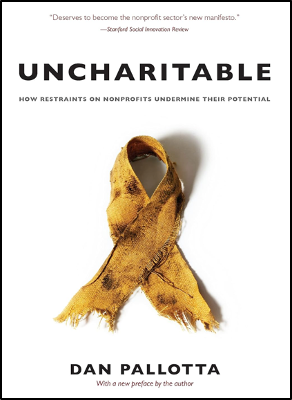From a Philanthropy Roundtable debate after original publication of the 2008 book by Dan Pallotta on which the new documentary film is based.
The new documentary film UnCharitable is based on Dan Pallotta’s 2008 book Uncharitable: How Restraints on Nonprofits Undermine Their Potential. The movie and the book, re-released in anticipation of the film, make a strong case for an entirely overhauled nonprofit sector—one in which charities would be freed from constraints imposed upon them.
Pallotta is a practitioner and promoter of, and a successful fundraiser for, big social-change projects. He was one of the founding partners for TED’s attention-getting and influential Audacious Project—which “encourages the world’s greatest changemakers to dream bigger,” then “shape[s] their ideas into viable multi-year plans and launch[es] them to the world alongside visionary philanthropists,” as it describes itself.

In 2009, the Philanthropy Roundtable hosted a debate at its annual meeting between Pallotta and William A. Schambra, now co-editor of The Giving Review. An edited version of Schambra’s remarks is below.
***
I want to make clear at the outset, Dan, that we owe you an enormous vote of thanks, for three reasons.
First, thanks for the millions of dollars you raised in a very short period of time for some extremely worthwhile causes, like AIDS and breast-cancer research. Very few in America can claim to have done as much as you have for those causes.
Second, thanks for writing a lively and thought-provoking book, Uncharitable. As we all know, the world of foundations and nonprofits is filled with mind-numbingly vapid and meaningless jargon and happy talk.
Very few in the field are willing to rock the boat, and you have shown yourself courageous enough to do so.
Third, thank you for elevating to such a prominent place in your analysis the role of capitalism and the free market.
As you argue so forcefully, the charity world all too often thinks it’s somehow superior to the world of self-interest and profit-making, when in fact charity is utterly dependent on the market and profits for its resources.
We are reminded here of the wisdom of the late Irving Kristol, who made precisely that observation in a speech to the Council on Foundations in 1980. As he put it:
Foundations are part and parcel of the private sector. They are flesh of the flesh, bone of the bone, blood of the blood of the private sector.
The notion that foundations in some way constitute a sector of their own, different from, above, and superior to the other two sectors [private and public] is an act of pride which will only go before a fall.
The Council on Foundations was not amused, and did not long put up with such heretical views, leading soon thereafter to the founding of the group under whose auspices we meet today.
But while we’re handing out thanks, we should be thankful to Steve Gunderson for his able leadership at the Council, wherein once again views that challenge and provoke have gotten a hearing. Don’t worry, Steve, we won’t say anything to your board.
But on the matter of the private sector, it’s worth remembering that even Irving Kristol, for all his admiration for capitalism, managed only two cheers for it, as the title of one of his books of essays suggested.
I’m afraid Mr. Pallotta, by contrast, may have gone a bit too far in his enthusiasm for capitalism.
For Mr. Pallotta’s is in fact a radically transformative project. He doesn’t want to just introduce more business-like practices into charity. Few here would quarrel with that.
He rather wants to make charity itself a business, able to pay its executives salaries comparable to the marketplace, to buy big-time advertising, to secure large chunks of capital from commercial sources, and even to provide investors a return on their capital.
The main obstacle to this radical change, he argues, is a Puritanical hang-up about keeping profit and self-interest out of charity, because, from the Mayflower on down, charity was supposed to be about a totally self-denying altruism.
But let’s think for a minute about the source of the charitable sector in America. It didn’t arise just from a hopelessly self-abnegating Puritanism.
It emerged rather from a broad-based American tradition of family, neighborhood, church, and community, reflecting what Alexis de Tocqueville described as the “science of association.”
Americans came together to help one another build their own communities not out of self-denying altruism, but rather out of what Tocqueville called “self-interest properly understood.”
I’m helping you harvest your hay today not because of some cosmic sense of brotherhood; I’m helping you today because you’ll help me with my hay tomorrow.
Over time, of course, the act of neighbor helping neighbor grew into the larger world of charitable organizations, which began to hire professionals to provide help.
But clearly, even today, as Mr. Pallotta points out, there is some sense that charity shouldn’t be just about making a buck, but rather about neighborly obligation.
Charity should, in the popular mind, involve some sacrifice of self-interest on behalf of a nobler end.
Not the radically ascetic self-sacrifice that Mr. Pallotta complains about, but nonetheless some modest, community-minded self-sacrifice, if only in the name of a more savvy and far-sighted self-interest.
Now, Mr. Pallotta wants to sweep all this goody-two-shoes stuff aside and put charity on a purely self-interested basis. For him, charity should be big business—big bucks for big programs funded by big advertising, which will go toe-to-toe with for-profit entities for the consumer dollar.
But there’s a deep internal contradiction here. If people typically support charity out of a sense of neighborliness and sacrifice, how can we raise money for it while trashing the primary motive for charitable giving?
Calling self-sacrifice Puritanical and repressive is to denigrate the very impulse that leads people to give freely of their time, talent, and treasure.
If charity is just another self-interested endeavor, why give to it when my self-interest recommends to me even more strongly that Dolce and Gabbana jacket or those Ferragamo shoes?
For Mr. Pallotta, charity has to be about big dollars and big programs because he has big aspirations for it. He doesn’t want just to put band-aids on problems; he wants to solve them once and for all.
In the final pages of his book, he notes that “where before we thought of opening a homeless shelter we need now to ask what it would take to end homelessness in our city. Let us challenge our cancer charities to band together and set a goal for the eradication of cancer within the next ten years,” and so forth.
Now, were charity to do this, it would not be the first time we’ve declared war on cancer or homelessness or poverty. It would not be the first time that we committed millions upon millions of dollars to huge social programs for those purposes. The Great Society springs to mind.
That was a government endeavor, of course. But from what we’ve seen of large-scale nonprofits and foundations, they readily become every bit as bureaucratic, unresponsive, ponderous, and sclerotic as the worst Great Society program.
The problems of bigness are present wherever bigness occurs. Why should the outcome of the next massive war on poverty be any different, just because the billions of dollars needed flow from charity rather than government?
Now, most sophisticated analysts of the nonprofit sector today insist that my account of charity is hopelessly out-of-date and backward-looking, based upon some village idyll that passed from the American scene centuries ago.
But is it? Consider the grantmaking represented in this room today. Most of you are, by contrast to Gates or Ford or Rockefeller, small to mid-sized donors.
When you write checks for ten or twenty thousand dollars, do you pour over statistics looking for the largest and most-effective national organization addressing your concerns, cheerfully sending your money off to Miami or New York or Los Angeles?
Or do you not in fact look first within your own city or community, for the groups doing the most good in your own backyard, typically measured not by abstract statistics, but rather by what you’ve heard from knowledgeable and trusted peers?
Some of you, of course, do both. But as long as a considerable portion of charity in America is motivated by the desire to improve our own community first, the village idyll so much despised by our sophisticated elites is alive and well and deserves our respect.
We show contempt for it only at the peril of striking at the root of the American charitable impulse.
The heart of Irving Kristol’s address to the Council on Foundations—indeed, the heart of his approach to social problems generally—was this:
It is possible to do good. It really is possible to do good. Doing good isn’t even hard. It’s just doing a lot of good that is very hard. If your aims are modest, you can accomplish an awful lot.
When your aims become elevated beyond a reasonable level, you not only don’t accomplish much, but can cause a great deal of damage.
Before we throw over the modest, ameliorative impulse at the core of American charity and embark on big, transformative projects with big goals and big money, let’s recall Mr. Kristol’s wisdom.
When we’re told that supporting the soup kitchen downtown is a waste of time and thinking too small because, if only we think big, the conquest of hunger is at hand, we need to remind ourselves that doing a little good isn’t hard, but doing a lot of good is.
When we forget that wisdom in the effort to solve eternal human problems once and for all by grand and dramatic measures, we may end doing more harm than good.




